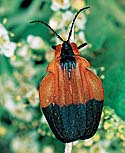|
Archostemata
Worldwide, there are three families in
the Archostemata, of which two occur in southern Africa. The third family,
Ommatidae, is only known from Australia. There are two known species in the
suborder from southern Africa: Cupes capensis (Cupedidae), which is
indigenous, and Micromalthus debilis (Micromalthidae), which is an introduced species
from the USA. Larvae of this suborder are all known to be borers into rotten
logs and fungus. |
 |
|
Myxophaga
Tiny beetles (< 2 mm long) that are associated with
aquatic and semi-aquatic habitats. There are about 60 described species
worldwide, of which less than 10 occur in southern Africa, falling into
the following families: Hydroscaphidae,
Microsporidae,
Torridincolidae (torrent beetles) and
Sphaeriidae.
|
|
|
Adephaga
The main characteristics that distinguish this taxon from
the other three at the same level:
(1) the first visible abdominal sternite (segment closest to
the thorax) is divided in two by
the coxae (the basal section of the hind leg).
(2) the wings at rest are not rolled.
(3) presence of a notopleural
suture (a join or seam between the top and bottom of the thorax).
There are
about 2005 species in southern Africa, of which
82% are in the Carabidae (ground beetles). The remaining
five families are all
aquatic: Aspidytidae, Dytiscidae (water beetles),
Gyrinidae (whirligig beetles),
Haliplidae and Rhysodidae.
|
 |
|
Polyphaga
This suborder includes the majority beetle families. The
main characteristics are:
(1) The first abdominal
sternite (segment closest the
thorax) not divided by the hind coxae, the bases of the hind legs.
2) Absence of a
notopleural suture (a join or seam
between the top and bottom of the thorax).
|
|
|
|
Superfamily:
Bostrychoidea
Includes the families: Anobiidae,
Bostrychidae,
Ptinidae and Lyctidae. |
 |
|
|
Superfamily: Buprestoidea
Single family: Buprestidae
(jewel beetles). |
 |
|
|
Superfamily: Byrrhoidea
Single family: Byrridae. |
|
|
|
Superfamily: Cantharoidea
Includes the following families: Cantharidae, Drilidae, Lampyridae
(fireflies, glow worms, and
Lycidae (net-winged beetles). |
 |
|
|
Superfamily: Chrysomeloidea
Two families: Cerambycidae (longicorn beetles, timber
beetles) and
Chrysomelidae (leaf beetles). The
Chrysomelidae includes the bruchid beetles (previously in the family
Bruchidae but now in the subfamily
Bruchinae). |
 |
|
|
Superfamily: Cleroidea
Includes the following families: Cleridae
(chequered beetles),
Melyridae (soft-winged flower beetles) and
Trogossitidae (gnawing beetles) |
 |
|
|
Superfamily: Cucujoidea
There are many families, including amongst others: Anthicidae,
Coccinellidae (ladybirds),
Discolomatidae,
Meloidae (blister beetles),
Nitidulidae,
Rhipiphoridae
and
Tenebrionidae
(darkling beetles, toktokkies). |
 |
|
|
Superfamily: Curculionoidea
Includes the following
families: Anthribidae,
Apionidae, Attelabidae,
Brachyceridae,
Brentidae,
Curculionidae and
Dryophthoridae |
 |
|
|
Superfamily: Dascilloidea
Two families: Dascillidae and Rhipiceridae
(parasitic comb beetles). |
 |
|
|
Superfamily: Dermestoidea
Two families: Dermestidae
(hide beetles, museum beetles)
and Thorictidae. |
 |
|
|
Superfamily: Dryopoidea
Includes the following families: Dryopidae, Elmidae,
Heteroceridae and Limnichidae |
|
|
|
Superfamily:
Elateroidea
Includes the following families: Elateridae
(click beetles), Eucnemidae and Throscidae. |
 |
|
|
Superfamily: Eucinetoidea
Small beetles found in decaying plant matter. There
are about 10 species with names known from
southern Africa but a number of others in museum collections that are
awaiting description. All three families in the superfamily have been
recorded from southern Africa: Clambidae,
Eucinetidae and
Helodidae. |
|
|
|
Superfamily:
Histeroidea
One family:
Histeridae (steel beetles, hister beetles). Histerids are usually black, with elytra not covering the entire
abdomen. The are found mainly in decaying organic matter such as dung, dead
animals and leaf litter. There are also species that live in termite colonies (termitophilous)
and others that live in ant nests (myrmecophilous). Adults and larvae are mainly
predators on larvae of beetles and flies but there are species that eat fungal
spores. |
 |
|
|
Superfamily: Hydrophiloidea
There are five families, all of which are found in
southern Africa:
Georyssidae, Hydraenidae,
Hydrochidae,
Hydrophilidae and
Spercheidae.
Four of them include exclusively aquatic species while in
the largest family - the Hydrophilidae - there are both aquatic
and terrestrial representatives. One of the characterisics of the family
is that in most species the maxillary palps are as long or longer than the
antennae. There are roughly 100 species
of Hydrophiloidea with names known from southern Africa. Includes the following
families: |
|
|
|
Superfamily:
Lymexyloidea
One family: Lymexylidae
(ship-timber beetles).
|
 |
|
|
Superfamily: Scarabaeoidea
Includes the following families: Acanthoceridae, Geotrupidae, Hybosoridae, Lucanidae, Passalidae,
Scarabaeidae
and
Trogidae |
 |
|
|
Superfamily: Staphylinoidea
A diverse group of beetles that live mainly in
decaying organic matter. Some are specialised to live in ant and termite nests.
The majority of species are either predators or feed on fungi but some species
have other food preferences. Approximately 1380 species with names are
known from southern Africa. Includes the following families:
Leiodidae, Pselaphidae,
Ptiliidae, Scaphidiidae,
Scydmaenidae,
Silphidae
and
Staphylinidae
|
 |
